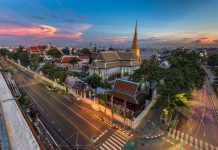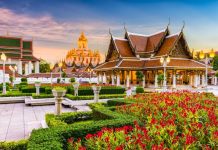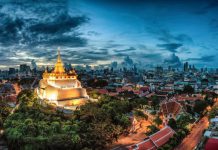
Witness the most elegant and longest Ubosot in Thailand at Wat Suthat Thepwararam
Bangkok, the metropolis of Thailand that voted as one of the most livable cities and tourist dream destinations in the world. The city is full in its infrastructure and facilities for tourism, shopping, architecture, and museum. In particular, the Buddhist temples in Bangkok which are the top tourist attractions that many travellers both local and worldwide pin as the must-not-miss place. Also, here we would like to introduce you one of the most important temples in Bangkok “Wat Suthat” or literally title is “Wat Suthat Thepwararam Maha Wora Vihara“. The holy complex is another iconic landmark for the tourists with the exotic, and elegant architectural of art included numbers of sacred objects which are worshipful among the Buddhist in this country.
History of the Temple
The temple was established by King Rama I of Chakri House, however, there was only the structure completed in his reign. Later, King Rama III bestowed to reconstruct the whole monastery complex, and it was additional renovated in by King Chulalongkorn (Rama V), respectively.
It assumed that the motivation to built this temple caused from the establishment of Rattanakosin Kingdom with the purpose to project the glory of the kingdom as same as Ayutthaya era which considered the time of “the Glorious Kingdom”. Therefore, any architectures in Rattanakosin period included palaces and temples mostly inherited from Ayutthaya, for example, Wat Suthat where is the house of “the Giant Buddha Image” that respectful invited from Sukhothai since Rama I which referred to Wat Phanan Choeng at Ayutthaya the old town.
Wat Suthat Thepwararam is a supreme grade of the first-class Buddhist temple in Bangkok which was established by King Rama I of Chakri Dynasty in 1807. The holy site has the original name as “Wat Maha Sutthawas”. The king initiated to build the complex to be the massive monastery equivalent to Wat Phana Choeng in order to be the honour splendour of the capital.
As well as the house to enshrine a significant Buddha image “Phra Si Sakkaya Munee (Phra To) which renowned for the local and foreigners as “the Giant Buddha” that invited from Wat Mahathat in Sukhothai. Then, the complex was announced to be a temple and named “Wat Phra To”, “Wat Phra Yai” (means Giant Buddha a same), or “Wat Sao Ching Cha” since it located adjacent to Sao Ching Cha (the Giant Swing). Unfortunately, the king passed away before the construction complete.
Afterwards, King Phra Phutthaloetla Naphalai or Rama II of Siam assigned to continue the construction of the monastery complex and he also graciously engraved the door panels himself. Unluckily, the king died before the temple finally finished in the reign of King Rama III, in 1847 and named “Wat Suthat Thepwararam” followed to the ancient annals. Noticeably, Wat Suthat has no any stupa as other temples; nonetheless there are “Satta maha Satha” which recognised the “Representative of the Lord Buddha” which are the 7 significant trees in Buddhism, instead. Within the complex, the magnificent wooden door panels which are the masterpiece of craving in the Rattanakosin era, specifically ones which are the handicraft of King Rama II that currently stored at Phra Nakorn National Museum. Moreover, Wat Suthat is a monument of the King Ananda Mahidol (Rama VIII) of Siam and the king’s ashes stored inside the front altar of “Phra Si Sakkaya Munee in the chapel in 1950. The merit-making ceremony in remembrance of King Rama VIII’s date of death has been set annually on June 9.
The Highlights of Wat Suthat
Lots of attractive things at Wat Suthat and here are the highlights that you should not miss to witness if you visit the place.
Ubosot of Wat Suthat
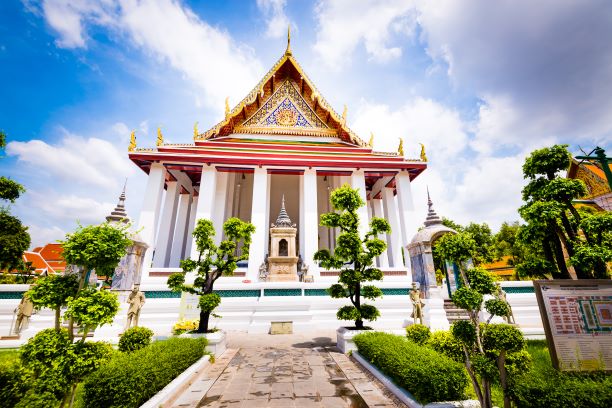
Ubosot or an ordination hall of Wat Suthat Thepwararam is one of the exotic and magnificent ordination halls in Thailand. The ubosot is also considered the longest ordination hall in the country, as well. The building was built in the reign of King Rama III where is the place to enshrine the principal Buddha image which is “Phra Tree Lokchet”. The image was cast in King Rama’s reign and enshrined as the main object in the ordination hall. Later, King Mongkut or Rama IV of Siam bestowed the name to the Buddha image as “Phra Tree Lokchet”, and in 1864 the king ordered to cast plastered figures of “Asitimahasavaka” the Eighty Great Disciples of the Buddha sit and salutation to listen to the great summons at the front of the main Buddha image.
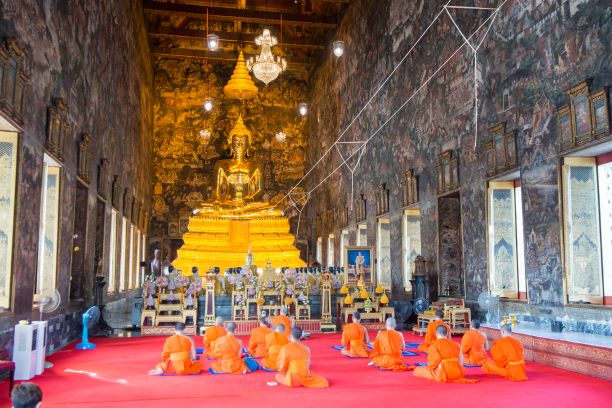
The interior is charismatic with the stunning mural painting by the master artists in Rama III, together with the door and window panels that are unique and fascinatingly beautiful. Surrounding the ordination hall are 8 Sema arches set on the top of the defensive wall. The Sema is a double leaves shape made from the grey marble and engraved in the figure of tri-head elephant raising a lotus bud with the blooming lotus beyond the image. Above the wall in the north and the south are the platforms in 4 directions to use as the donation pavilion during the royal ceremonies. There is a painting which is the image of a hungry ghost lay down with a monk was very famous in the past and as a trademark of the temple that any visitors who come to the temple should not miss.
Vihara of Wat Suthat

A royal sanctuary decorated with the exquisite door panels. The panel which engraved in the delicate and realistic pattern of plants, flowers, and creatures that is the craftsmanship of King Rama II. The king created the design and graciously initial engraved the work; then he assigned to the craftsman to finish the job. Consequently, the exotic and marvellous piece of art. Unfortunately, some part of them burnt in the fire, and some are stored at the Phra Nakorn National Museum. The vihara is the house of “Phra Si Sakkaya Muneet” the 8-meter high Buddha image in the attitude of subduing Mara which brought from Sukhothai province. This is s-called the most important sacred object of the complex that well-known among the Buddhist as “the Giant Buddha” of Wat Suthat.
The interior of the vihara is the mural painting about the famous Wat Suthat hungry ghosts. According to Buddhist belief, these demons committed the sin when they live, so that they got the most misery retribution when they deceased.
Phra Vihara Khot

Phra Vihara Khot or Phra Rabieng Khot (the cloister) which was constructed in the period of King Rama III environing all four directions of the sanctuary. Each corner of the veranda is the four gable ends style with the subduing Mara Buddha image housed inside, included the numbers of the Buddha images in the attitude of meditation all around the space.
Satta Maha Sathan
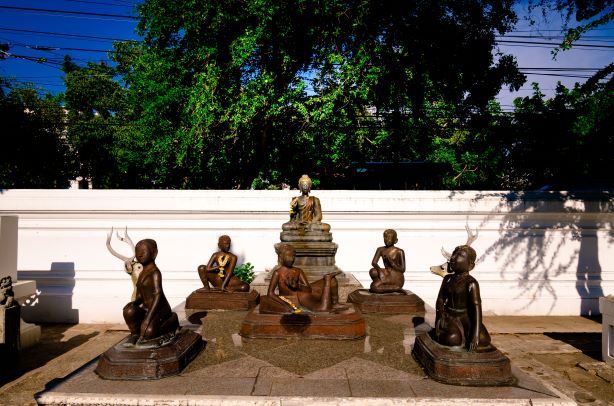
The word “Satta Maha Sathan” means the seven essential places where the Lord Buddha stayed after his enlightenment. At Wat Suthat, there is the representative of the Satta Maha Sathan which is another vital structure at the monastery. The sacred things were cast by order of King Rama III instead of building the pagoda as same as another temples favour.
Apart from that, many other sacred objects and structures in the temple are all appealing to witness. Also, noticeably around the monastery complex are the sculptures with the outlandish costume. Last but not least, the Giant Swing located at the front of the temple is so-called the iconic symbol of the location which is another popular spot for the tourists to take the photos especially during the silhouette of the sunset.
Paying Homage to “Phra Si Sakkaya Munee Buddha”

Wat Suthat or also renowned locally is “Wat Phra Yai” or “Wat Phra To” since the ordination hall is the house to enshrine the most revered Buddha image which is the most massive bronze Buddha image in Thailand named “Phra Si Sakkaya Munee”.
“Phra Si Sakkaya Munee” is a principal sacred object enshrined inside the vihara. The image was respectively relocated from Sukhothai is a bronze Buddha in the attitude of subduing Mara. The image is a copy of the Buddha image in the vihara at Wat Mongkol Bophit in Ayutthaya province with the lap size approximately 6 meters. It considered the biggest moulded Buddha Image in the country of the pre-Sambuddha Jayanthi – the 25th millennium anniversary of Buddhism.
The story of Phra Si Sakkaya Munee
Phra Si Sakkaya Munee was cast in the period of Phra Ruang of the Sukhothai Kingdom, then King Rama I of Chakri invited the sacred image to enshrine in Bangkok. With that purpose, the king also planned to build a royal temple to be as large as Wat Phanan Choeng in Ayutthaya in the centre of the capital at that time. The image arrived at Bangkok and stayed at Somphot Pier for 7 days then transported by the barge procession to the temple. However, it was only set up the Buddha image over the altar in his reign.
The remarkable logistics of the most elegant Buddha image in time implemented by an enormous raft and sailed along the river which could be a fascinating event. The model once arrived at the temple could not enter through the city gate, hence part of the gate and wall needed to tear down to let the Buddha image in and situated on the vihara’s foundation. King Rama I presided over the ceremony even though he was unwell.
“The Giant Buddha” is a Sukhothai art with over 8 centuries of age, undoubtedly the Buddha image needed some renovation. King Rama I ordered to fix the image according to the Atthakatha – the Pali to explain the commentary. Once the Buddha image was enshrined at the temple resulted in the people call the temple “Wat Phra Yai” or Wat Phra To” which means the temple of the giant Buddha. Nevertheless, the temple initial named as “Wat Suthat Theptharam” in Rama II’s era and renamed to “Wat Suthat Thepphararam” in the reign of King Rama III. While the important Buddha image was bestowed the title “Phra Si Sakkaya Munee” in the period of King Chulalongkorn, the Rama IV of Siam.
When King Ananda Mahidol or Rama VIII passed away, the late King Bhumibhol graciously invited his ashes to store inside the altar of Phra Si Sakkaya Munee dated April 4, 1950. Moreover, he also scheduled date of June 9 annually to make the royal ceremony of the merit-making in remembrance to the King Ananda Mahidol at the vihara, Wat Suthat.
Wat Suthat Thepwararam opens daily between 6.00am-6.30pm, however, please check at the location for the time to enter the chapel and the ordination hall according to the first-class royal monastery regulations. Any tourists who plan to take a tour in Bangkok should not miss visiting the temple since it is not only to worship the sacred Phra Si Sakkaya Munee Buddha image for prosperity, but also the temple has a broad array of attractive things have waited for the travellers to witness.
Travelling to Wat Suthat
Wat Suthat sites on Bamrung Muang Road in the old city district nearby the Bangkok City Hall and just about 1 kilometre East of the Grand Palace.
There are no any BTS Skytrain or MRT Metro stations nearby. The best way to get there is by taxi or by Took Took, depending on the distance.

